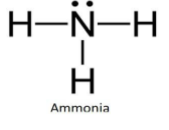
What is the formal charge present on nitrogen in ammonia ($N{{H}_{3}}$ )
A. +2
B. +1
C. +3
D. 0
Answer
561k+ views
Hint: To solve this question first we have to identify the number of valence electrons present in each atom in ammonia. And draw the Lewis dot structure of ammonia and find out the number of bonding and number of non bonding electrons present with each atom.
Complete step by step solution:
Now to calculate the formal charge on $N{{H}_{3}}$ or the value of the formal charge on the N atom.

We can calculate the formal charge on an ion by using the formula= $V-N-\dfrac{B}{2}$
Where V = valence electrons in a free atom i.e. the number of electrons present in the valence shell of an atom in Free State.
B = number of electrons shared in the covalent bond i.e. if there is formation of covalent bond then we will write down the electrons shared in the covalent bond.
N = number of electrons in a lone pair i.e. the electrons which do not participate in formation of bond
In the case of N the value of
V = valence electron in free atom = 5
B = number of electrons in the covalent bond = 6
N = number of electrons in a lone pair= 2
After putting all the value in above equation we get the formal charge = $5-2-\dfrac{6}{2}$
The formal charge on nitrogen in ammonia = 0
Hence the correct answer is option (D).
Note: Formal charge is the charge which is assigned to an atom in the molecule assuming that the electrons present in all the chemical bonds are shared between the atoms regardless of the electronegativity of the atom.
Complete step by step solution:
Now to calculate the formal charge on $N{{H}_{3}}$ or the value of the formal charge on the N atom.

We can calculate the formal charge on an ion by using the formula= $V-N-\dfrac{B}{2}$
Where V = valence electrons in a free atom i.e. the number of electrons present in the valence shell of an atom in Free State.
B = number of electrons shared in the covalent bond i.e. if there is formation of covalent bond then we will write down the electrons shared in the covalent bond.
N = number of electrons in a lone pair i.e. the electrons which do not participate in formation of bond
In the case of N the value of
V = valence electron in free atom = 5
B = number of electrons in the covalent bond = 6
N = number of electrons in a lone pair= 2
After putting all the value in above equation we get the formal charge = $5-2-\dfrac{6}{2}$
The formal charge on nitrogen in ammonia = 0
Hence the correct answer is option (D).
Note: Formal charge is the charge which is assigned to an atom in the molecule assuming that the electrons present in all the chemical bonds are shared between the atoms regardless of the electronegativity of the atom.
Recently Updated Pages
Master Class 12 Business Studies: Engaging Questions & Answers for Success

Master Class 12 Economics: Engaging Questions & Answers for Success

Master Class 12 English: Engaging Questions & Answers for Success

Master Class 12 Maths: Engaging Questions & Answers for Success

Master Class 12 Social Science: Engaging Questions & Answers for Success

Master Class 12 Chemistry: Engaging Questions & Answers for Success

Trending doubts
What is meant by exothermic and endothermic reactions class 11 chemistry CBSE

Which animal has three hearts class 11 biology CBSE

10 examples of friction in our daily life

One Metric ton is equal to kg A 10000 B 1000 C 100 class 11 physics CBSE

1 Quintal is equal to a 110 kg b 10 kg c 100kg d 1000 class 11 physics CBSE

Difference Between Prokaryotic Cells and Eukaryotic Cells




